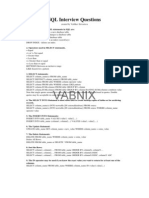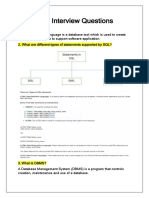0 ratings0% found this document useful (0 votes)
37 viewsSQL Interview Questions
The document discusses various SQL concepts including indexes, constraints, aggregate functions, and differences between UNION and UNION ALL, DELETE and TRUNCATE statements, clustered and non-clustered indexes. It provides definitions and explanations of indexes, constraints like NOT NULL, UNIQUE, PRIMARY KEY. It explains the functions of UNION, INTERSECT, MINUS operators and conditions to use them. It also summarizes the differences between DELETE and TRUNCATE, and lists some common aggregate functions in SQL.
Uploaded by
Automation QA1Copyright
© © All Rights Reserved
Available Formats
Download as DOCX, PDF, TXT or read online on Scribd
0 ratings0% found this document useful (0 votes)
37 viewsSQL Interview Questions
The document discusses various SQL concepts including indexes, constraints, aggregate functions, and differences between UNION and UNION ALL, DELETE and TRUNCATE statements, clustered and non-clustered indexes. It provides definitions and explanations of indexes, constraints like NOT NULL, UNIQUE, PRIMARY KEY. It explains the functions of UNION, INTERSECT, MINUS operators and conditions to use them. It also summarizes the differences between DELETE and TRUNCATE, and lists some common aggregate functions in SQL.
Uploaded by
Automation QA1Copyright
© © All Rights Reserved
Available Formats
Download as DOCX, PDF, TXT or read online on Scribd
You are on page 1/ 2
How to test the Stored Procedures?
What do you mean by index and explain different types of indexes?
Answer: An Index is a database object, created on a column of the table to find data
more quickly and efficiently (or we can say, it is used to speed up the searches/queries).
How to write a query to get the second largest value from a given column of a
table?
What is the function of Union operator?
What is the difference between Union and Union All?
What is SQL Injection threat?
What are Constraints in SQL?
NOT NULL - Restricts NULL value from being inserted into a column.
CHECK - Verifies that all values in a field satisfy a condition.
DEFAULT - Automatically assigns a default value if no value has been specified
for the field.
UNIQUE - Ensures unique values to be inserted into the field.
INDEX - Indexes a field providing faster retrieval of records.
PRIMARY KEY - Uniquely identifies each record in a table.
FOREIGN KEY
What is the difference between Clustered and Non-
clustered index?
As explained above, the differences can be broken down into three small factors -
1. Clustered index modifies the way records are stored in a database based on the
indexed column. Non-clustered index creates a separate entity within the table which
references the original table.
2. Clustered index is used for easy and speedy retrieval of data from the database,
whereas, fetching records from the non-clustered index is relatively slower.
3. In SQL, a table can have a single clustered index whereas it can have multiple
non-clustered indexes.
What are UNION, MINUS and INTERSECT
commands?
The UNION operator combines and returns the result-set retrieved by two or more
SELECT statements.
The MINUS operator in SQL is used to remove duplicates from the result-set obtained
by the second SELECT query from the result-set obtained by the first SELECT query
and then return the filtered results from the first.
The INTERSECT clause in SQL combines the result-set fetched by the two SELECT
statements where records from one match the other and then returns this intersection of
result-sets.
Certain conditions need to be met before executing either of the above statements in
SQL -
Each SELECT statement within the clause must have the same number of
columns
The columns must also have similar data types
The columns in each SELECT statement should necessarily have the
same order
SELECT name FROM Students /* Fetch the union of queries */
UNION
SELECT name FROM Contacts;
SELECT name FROM Students /* Fetch the union of queries with duplicates*/
UNION ALL
SELECT name FROM Contacts;
SELECT name FROM Students /* Fetch names from students */
MINUS /* that aren't present in contacts */
SELECT name FROM Contacts;
SELECT name FROM Students /* Fetch names from students */
INTERSECT /* that are present in contacts as well */
SELECT name FROM Contacts;
What is the difference between DELETE and
TRUNCATE statements?
The TRUNCATE command is used to delete all the rows from the table and free the
space containing the table.
The DELETE command deletes only the rows from the table based on the condition
given in the where clause or deletes all the rows from the table if no condition is
specified. But it does not free the space containing the table.
Name some Aggregate functions in SQL?
AVG() - Calculates the mean of a collection of values.
COUNT() - Counts the total number of records in a specific table or view.
MIN() - Calculates the minimum of a collection of values.
MAX() - Calculates the maximum of a collection of values.
SUM() - Calculates the sum of a collection of values.
FIRST() - Fetches the first element in a collection of values.
LAST() - Fetches the last element in a collection of values.
You might also like
- The Most Important DDL Statements in SQL Are0% (1)The Most Important DDL Statements in SQL Are138 pages
- What Is Major Difference Between SQL and PLSQL?No ratings yetWhat Is Major Difference Between SQL and PLSQL?70 pages
- Index: S.N O. Experiment Date Remark S T. SignNo ratings yetIndex: S.N O. Experiment Date Remark S T. Sign34 pages
- SQL Commands: A Data Type Defines What Kind of Value A Column Can ContainNo ratings yetSQL Commands: A Data Type Defines What Kind of Value A Column Can Contain12 pages
- 5 SQL86 DDL Data Manipulation Commit GrantNo ratings yet5 SQL86 DDL Data Manipulation Commit Grant14 pages
- Syntax: (Common) Elements in Two Sets or Common Records From Two or More Tables. inNo ratings yetSyntax: (Common) Elements in Two Sets or Common Records From Two or More Tables. in5 pages
- Practical File: Database Management SystemNo ratings yetPractical File: Database Management System27 pages
- Unit I: DBMS (Database Management System)No ratings yetUnit I: DBMS (Database Management System)26 pages
- Experiment 7 - To Implement Different Operators (LIKE, BETWEEN, IN, Wildcards)No ratings yetExperiment 7 - To Implement Different Operators (LIKE, BETWEEN, IN, Wildcards)6 pages
- 2025-03-20_09-11-56_425I3lAqf5I5WG9WyJ36RBFIDxAFdY8i5nWZEZfFNo ratings yet2025-03-20_09-11-56_425I3lAqf5I5WG9WyJ36RBFIDxAFdY8i5nWZEZfF14 pages
- SQL Lab File (1-10) - Tushar-21scse2030128No ratings yetSQL Lab File (1-10) - Tushar-21scse203012844 pages
- Difference Between Varchar and Varchar2 Data Types?: Salary Decimal (9,2) Constraint Sal - CK Check (Salary 10000)No ratings yetDifference Between Varchar and Varchar2 Data Types?: Salary Decimal (9,2) Constraint Sal - CK Check (Salary 10000)4 pages
- Advanced SAS Interview Questions You'll Most Likely Be AskedFrom EverandAdvanced SAS Interview Questions You'll Most Likely Be AskedNo ratings yet
- The SQL Workshop: Learn to create, manipulate and secure data and manage relational databases with SQLFrom EverandThe SQL Workshop: Learn to create, manipulate and secure data and manage relational databases with SQLNo ratings yet
- Types of E-Resources and Its Utilities in Library 9No ratings yetTypes of E-Resources and Its Utilities in Library 99 pages
- Sap-Novasoft-Erp Implementation On Pantaloons: Submitted byNo ratings yetSap-Novasoft-Erp Implementation On Pantaloons: Submitted by11 pages
- Status and Future of Manufacturing Execution Systems: Emrah Arica, Daryl PowellNo ratings yetStatus and Future of Manufacturing Execution Systems: Emrah Arica, Daryl Powell6 pages
- Common Data Model For Identity Access Management DataNo ratings yetCommon Data Model For Identity Access Management Data45 pages
- 98-364.exam.70q: Number: 98-364 Passing Score: 800 Time Limit: 120 MinNo ratings yet98-364.exam.70q: Number: 98-364 Passing Score: 800 Time Limit: 120 Min45 pages
- TEDAS: A Twitter-Based Event Detection and Analysis SystemNo ratings yetTEDAS: A Twitter-Based Event Detection and Analysis System4 pages
- Module Title Module 1: Database Environment Learning ObjectivesNo ratings yetModule Title Module 1: Database Environment Learning Objectives6 pages
- Perancangan Sistem Inventori Barang Pada Rehat Kopi 32 Berbasis WebNo ratings yetPerancangan Sistem Inventori Barang Pada Rehat Kopi 32 Berbasis Web7 pages
- Orange Lecture04 - Training Prediction (2)No ratings yetOrange Lecture04 - Training Prediction (2)9 pages
- Diabetes Prediction Using Data Mining: 1. AdminNo ratings yetDiabetes Prediction Using Data Mining: 1. Admin2 pages
- Pembangunan Jaringan Komputer Studi Kasus CV Dino Mandiri KaranganyarNo ratings yetPembangunan Jaringan Komputer Studi Kasus CV Dino Mandiri Karanganyar7 pages
- Tugas Aksel Ti - Ulviyanti Durrotul Falihah - 205000020 - BK - Kls FNo ratings yetTugas Aksel Ti - Ulviyanti Durrotul Falihah - 205000020 - BK - Kls F6 pages

























































































